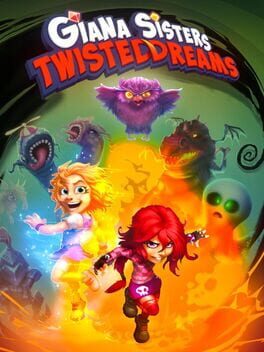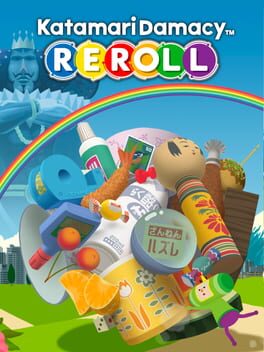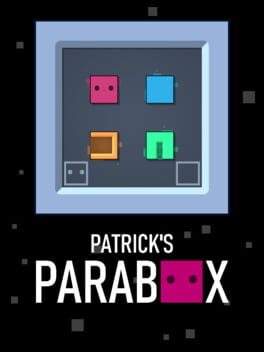rylirk
Bio
Crawley, UK. Former astrophysicist, current research software engineer. I write full reviews for everything I've completed/abandoned since 2020, and rate everything I've played since ~2008.
Ratings correspond to:
5: Absolutely outstanding video game, everyone should play this.
4.5: Either a very solid game all-round or an outstanding game with one or two significant flaws.
4: Very solid and highly memorable.
3.5: A strong game that is perhaps not as memorable or standout as 4-stars+, but still highly recommended.
3: A good game. I enjoyed it.
2.5: In general, I still enjoyed this game but there are some major problems I cannot overlook.
2: A game that left me pretty neutral, or a game that I can see the merits of but is definitively Not For Me.
1.5: Uninspired, dull or otherwise poor, but still playable.
1: Very poor but, if I squint real hard, I can still pick out maybe one or two redeeming qualities.
0.5: Irredeemable garbage, don't play it.
Crawley, UK. Former astrophysicist, current research software engineer. I write full reviews for everything I've completed/abandoned since 2020, and rate everything I've played since ~2008.
Ratings correspond to:
5: Absolutely outstanding video game, everyone should play this.
4.5: Either a very solid game all-round or an outstanding game with one or two significant flaws.
4: Very solid and highly memorable.
3.5: A strong game that is perhaps not as memorable or standout as 4-stars+, but still highly recommended.
3: A good game. I enjoyed it.
2.5: In general, I still enjoyed this game but there are some major problems I cannot overlook.
2: A game that left me pretty neutral, or a game that I can see the merits of but is definitively Not For Me.
1.5: Uninspired, dull or otherwise poor, but still playable.
1: Very poor but, if I squint real hard, I can still pick out maybe one or two redeeming qualities.
0.5: Irredeemable garbage, don't play it.
Badges

Listed
Created 10+ public lists

Popular
Gained 15+ followers

Elite Gamer
Played 500+ games

1 Years of Service
Being part of the Backloggd community for 1 year

GOTY '23
Participated in the 2023 Game of the Year Event

Donor
Liked 50+ reviews / lists

Loved
Gained 100+ total review likes

Pinged
Mentioned by another user

Roadtrip
Voted for at least 3 features on the roadmap

Best Friends
Become mutual friends with at least 3 others

Gamer
Played 250+ games

Shreked
Found the secret ogre page

Noticed
Gained 3+ followers

Liked
Gained 10+ total review likes

Gone Gold
Received 5+ likes on a review while featured on the front page

N00b
Played 100+ games
Favorite Games
546
Total Games Played
000
Played in 2024
127
Games Backloggd
Recently Reviewed See More
I didn't get far into this before giving up, and I'm blaming that on the control scheme. The Steam port is actually unplayable on controller: the camera immediately pans hard to the top-left for no reason and Giana likes to have switching fits where she toggles about once a frame for a few seconds every now and again, even if I'm not touching the controller. Even if it had worked, the control layout is baffling (why the fuck is pause bound to R1!?), and the keyboard controls are equally horrendous and of course cannot be changed. I don't know if maybe this would work better with a different controller or if something is going wrong due to the sheer age of the game but either way, from what I've played, I really don't think I'm missing much by giving up on it.
The visuals are... let's say 'technically impressive' given when this game came out. Considering this game came out in 2012 it really doesn't look that old, and its aesthetics have aged remarkably well. Those aesthetics are, however, absolutely hideous. Like, the game definitely has a style to it, but it just looks so damned ugly... the colour pallette is all over the place, nothing really gels together ('because dream' I guess) and the general creature and object design is bloated and deliberately gross. I can appreciate a lot of effort has gone into this in terms of the visuals, but in my opinion this game looks worse than Cruelty Squad.
The level design also seems to be a big nothing-burger as well. Again, I only got to near the end of the first world, so maybe it all ramps up and becomes a gameplay masterpiece later on. But from what I played, Giana Sisters is based on a solid core concept, likes introducing new puzzle pieces and ways to interact with the environment and then applying them in the most piecemeal and phoned in way possible. You spend the entire game switching between a character with a dash and a character with a double-jump, and you could do so much with that in terms of movement, but the game would rather have you ride a moving elevator twice so that each character can pick up all the gems specified for them, or have you jump across platforms that disappear and reappear when you switch with no regard for the character's different movesets. The entire game is basically just the second mask from Crash Bandicoot 4 but implemented in an incredibly sloppy way that makes no use of its potential. No, the game is much more interested in positioning enemies perfectly off-screen so that you'll run into them before you have a chance to avoid them. Or placing a gem for character 1 behind a barrier that only opens for character 2, making me assume I had to switch and then dash through before the gate has a chance to close... it really shouldn't be this easy to softlock level 2 of a platformer for fuck's sake.
So yeah, I didn't like this. Admittedly my main issues were technical issues which I'm going to assume are specific to the version I played, but I really don't feel too sad about skipping this one based on the experience I was able to have. In any case, the final straw was entering a level and seeing 0/700 gems on the UI... yeah, no thanks, I'm good. There are so many great platformers out there, including from the same era as this... just go and pick any one of those and I'm sure you'll have a better time.
The visuals are... let's say 'technically impressive' given when this game came out. Considering this game came out in 2012 it really doesn't look that old, and its aesthetics have aged remarkably well. Those aesthetics are, however, absolutely hideous. Like, the game definitely has a style to it, but it just looks so damned ugly... the colour pallette is all over the place, nothing really gels together ('because dream' I guess) and the general creature and object design is bloated and deliberately gross. I can appreciate a lot of effort has gone into this in terms of the visuals, but in my opinion this game looks worse than Cruelty Squad.
The level design also seems to be a big nothing-burger as well. Again, I only got to near the end of the first world, so maybe it all ramps up and becomes a gameplay masterpiece later on. But from what I played, Giana Sisters is based on a solid core concept, likes introducing new puzzle pieces and ways to interact with the environment and then applying them in the most piecemeal and phoned in way possible. You spend the entire game switching between a character with a dash and a character with a double-jump, and you could do so much with that in terms of movement, but the game would rather have you ride a moving elevator twice so that each character can pick up all the gems specified for them, or have you jump across platforms that disappear and reappear when you switch with no regard for the character's different movesets. The entire game is basically just the second mask from Crash Bandicoot 4 but implemented in an incredibly sloppy way that makes no use of its potential. No, the game is much more interested in positioning enemies perfectly off-screen so that you'll run into them before you have a chance to avoid them. Or placing a gem for character 1 behind a barrier that only opens for character 2, making me assume I had to switch and then dash through before the gate has a chance to close... it really shouldn't be this easy to softlock level 2 of a platformer for fuck's sake.
So yeah, I didn't like this. Admittedly my main issues were technical issues which I'm going to assume are specific to the version I played, but I really don't feel too sad about skipping this one based on the experience I was able to have. In any case, the final straw was entering a level and seeing 0/700 gems on the UI... yeah, no thanks, I'm good. There are so many great platformers out there, including from the same era as this... just go and pick any one of those and I'm sure you'll have a better time.
I think I enjoyed this? I never played the original, so this is my first introduction to the series as a whole, and I can understand the appeal. It's weird, joyful, chaotic, cathartic... Katamari certainly isn't afraid of being different and, for the most part, it works.
But while playing this game there was always something in the back of my mind preventing me from enjoying it to the fullest, and it took a long time to figure out what it was. My initial thought was the aesthetics; I don't get on with 'cutesy for cutesy's sake' as a design choice but, while Katamari definitely is cutesy, the sheer hectic bizarreness of its premise won me over on that front. I see a lot of people giving this game credit for its soundtrack; I agree that some of the music is great (the title theme in particular, but I found the more swingy/loungy tracks to be pretty great too), but it has to be one of the least cohesive soundtracks I've ever heard, and some of the tracks are actively bad. I didn't particularly enjoy listening to a robot tell me I'm smart for 20 minutes, nor did I enjoy having to listen to children who literally couldn't hold a note at all... So the music ended up being a very mixed bag for me, but it definitely wasn't what was bugging me about this game.
So my second thought was maybe the controls were the issue: the tank controls in this game are clunky and awkward to say the least. This game is absolutely unplayable keyboard and mouse (which to be fair would obviously not have been a consideration for the original), but it can be equally painful to play with a controller. Very early I switched to the 'simple controls' layout which was honestly such a trap; the controls are indeed slightly simpler (albeit still clunky), but at the cost of a huge amount of your manoevrability. I definitely recommend sticking with the default controls and, when I went back to them and really tried to learn them, it almost felt like the shitty controls were a deliberate part of the game's difficulty. Don't get me wrong, I don't like the control scheme in this game, but by the end I didn't hate them either.
So finally I decided that what put me off this game was its level design and pacing. Some of the levels are great, with a constant stream of slightly larger items to keep absorbing; you always feel like you are making progress, and the sheer visceral nature of absorbing everything around you delivers a nice steady stream of dopamine to your lizard brain. But then in a lot of the levels, there just seem to be gaps in the object size chain. What I mean by this is I would be exploring a level and get to, say, 1.9m, only to find that every object I could see around me was either slightly too big to absorb or too small to have any notable difference on my katamari size. And then suddenly everything comes to a screeching halt. I would be left either with the option of exploring the level in depth to find some pocket of untapped mass (not a fun prospect at all given the aforementioned trash player controls and lack of any camera control), or resign myself to spending ages mopping up tiny things around me until I could creep over the critical threshold to start collecting things above the mass gap. This sounds like a minor issue, but the entertainment value in Katamari is so surface level and mindless that these gaps in play absolutely destroy the flow. Bear in mind that me calling the game surface level and mindless is not meant as an insult: I love some far more vapid games such as Cookie Clicker and Vampire Survivors, but these hold my attention so much better than Katamari because they just don't have gaps in their feedback loops.
I don't want to be too down on Katamari though. At its best it really is an incredibly cathartic experience. Especially in levels where you start and end at completely different size scales, it feels great to end up mopping up tiny objects that started out as impossibly distant background details. The change in the scale of the world is very gradual and very nicely done as you grow; there were multiple times where I had a great 'a-ha!' moment upon realising that I'd ended up back in the starting area but now everything was 1/5 the size. The Katamari itself always showing what it's made of is a masterstroke as well; it really helps with the organic changes of scale in the game, and helps give a visceral sense of achievement when you can simply look at your character and see how much garbage you've managed to roll up. Katamari deals with both this scale and this sense of progression so much better than the heavily-inspired Donut County that it's absolutely night and day, and I would 100% recommend this game over Donut County any day of the week.
So all in all, a mixed bag experience for me. I'm very glad this exists, and commend how experimental it's willing to be (especially given the era that the original version came out). I wouldn't say it lives up to the near-legendary plinth that the gaming community seems to have placed it on, but it's a decent little game and overall I am glad to have played it.
But while playing this game there was always something in the back of my mind preventing me from enjoying it to the fullest, and it took a long time to figure out what it was. My initial thought was the aesthetics; I don't get on with 'cutesy for cutesy's sake' as a design choice but, while Katamari definitely is cutesy, the sheer hectic bizarreness of its premise won me over on that front. I see a lot of people giving this game credit for its soundtrack; I agree that some of the music is great (the title theme in particular, but I found the more swingy/loungy tracks to be pretty great too), but it has to be one of the least cohesive soundtracks I've ever heard, and some of the tracks are actively bad. I didn't particularly enjoy listening to a robot tell me I'm smart for 20 minutes, nor did I enjoy having to listen to children who literally couldn't hold a note at all... So the music ended up being a very mixed bag for me, but it definitely wasn't what was bugging me about this game.
So my second thought was maybe the controls were the issue: the tank controls in this game are clunky and awkward to say the least. This game is absolutely unplayable keyboard and mouse (which to be fair would obviously not have been a consideration for the original), but it can be equally painful to play with a controller. Very early I switched to the 'simple controls' layout which was honestly such a trap; the controls are indeed slightly simpler (albeit still clunky), but at the cost of a huge amount of your manoevrability. I definitely recommend sticking with the default controls and, when I went back to them and really tried to learn them, it almost felt like the shitty controls were a deliberate part of the game's difficulty. Don't get me wrong, I don't like the control scheme in this game, but by the end I didn't hate them either.
So finally I decided that what put me off this game was its level design and pacing. Some of the levels are great, with a constant stream of slightly larger items to keep absorbing; you always feel like you are making progress, and the sheer visceral nature of absorbing everything around you delivers a nice steady stream of dopamine to your lizard brain. But then in a lot of the levels, there just seem to be gaps in the object size chain. What I mean by this is I would be exploring a level and get to, say, 1.9m, only to find that every object I could see around me was either slightly too big to absorb or too small to have any notable difference on my katamari size. And then suddenly everything comes to a screeching halt. I would be left either with the option of exploring the level in depth to find some pocket of untapped mass (not a fun prospect at all given the aforementioned trash player controls and lack of any camera control), or resign myself to spending ages mopping up tiny things around me until I could creep over the critical threshold to start collecting things above the mass gap. This sounds like a minor issue, but the entertainment value in Katamari is so surface level and mindless that these gaps in play absolutely destroy the flow. Bear in mind that me calling the game surface level and mindless is not meant as an insult: I love some far more vapid games such as Cookie Clicker and Vampire Survivors, but these hold my attention so much better than Katamari because they just don't have gaps in their feedback loops.
I don't want to be too down on Katamari though. At its best it really is an incredibly cathartic experience. Especially in levels where you start and end at completely different size scales, it feels great to end up mopping up tiny objects that started out as impossibly distant background details. The change in the scale of the world is very gradual and very nicely done as you grow; there were multiple times where I had a great 'a-ha!' moment upon realising that I'd ended up back in the starting area but now everything was 1/5 the size. The Katamari itself always showing what it's made of is a masterstroke as well; it really helps with the organic changes of scale in the game, and helps give a visceral sense of achievement when you can simply look at your character and see how much garbage you've managed to roll up. Katamari deals with both this scale and this sense of progression so much better than the heavily-inspired Donut County that it's absolutely night and day, and I would 100% recommend this game over Donut County any day of the week.
So all in all, a mixed bag experience for me. I'm very glad this exists, and commend how experimental it's willing to be (especially given the era that the original version came out). I wouldn't say it lives up to the near-legendary plinth that the gaming community seems to have placed it on, but it's a decent little game and overall I am glad to have played it.
I've played a fair few Sokoban-likes since making an effort to play a wider variety of games. And I think in general... the subgenre isn't really for me? Don't get me wrong, there are some Sokobans I have really enjoyed and appreciated: the genius concept of Baba Is You and the organic simplicity and focus on player discovery in Stephen's Sausage Roll make these among some of the best made puzzle games I've played. But there always becomes a point in these games where frustration overtakes me... when the number of interacting mechanics becomes too great, or the convoluted solutions to the puzzles become too clever for their own good. When the artificial complexity begins to outpace the more organic complexity of one of these games' premises, I always find myself losing interest. Well... that didn't happen with Parabox. Patrick's Parabox starts off a little slow but before long it had grabbed onto me completely and, despite my checkered record on that front, I didn't find myself cheating on a puzzle even once. In terms of pacing, level design and player experience, I would now rate this to be the best Sokoban I've played.
The premise of Parabox is fantastic; the recursion theme is great and requires some really lateral thinking. The actual number of distinct rules the game introduces is surprisingly small, and most of the puzzles are less about applying them in an awkward way and more about exploring the way they interact and their natural corollories. It meant that every time I got stuck on a puzzle it was generally because there was an implication to one of the rules I hadn't worked out yet, and it meant each of these sticking points ended in a great 'a-ha!' moment when I finally managed to solve it. In terms of both the recursive theme and this focus on streamlined puzzles, Parabox reminds me a lot of Cocoon; but while Cocoon came off as being very handholdy and afraid of reaching it's full potential with its puzzles, Parabox is much more trusting of its player's intelligence, and really wrings out every ounce of puzzle potential from its core ruleset. In short, Parabox is pretty much exactly the game I wish Cocoon had been.
There's not much here to write home about in terms of aesthetics, though. I'm not really a huge fan of the music, the visuals are very simplistic and there is no attempt to really have any kind of theming or framework. At first this can make the game seem rather sparse, especially in the early levels where not a whole lot is going on. But once you enter the mid-game and the complexity really starts ramping up, this visual simplicity becomes much more of a blessing than a curse. In particular the use of simple shapes and bright block colours makes it remarkably clear what's going on no matter how crazy the play area gets; the game has the option for you to zoom into any box at any time to see what's happening inside, but the visual design was so clean that I almost never felt the need to.
So yes, all around, a very solid little puzzler. It's a very pure game; like I said, there's no real atmosphere or interesting visuals to speak of, but Parabox really goes all in on its puzzles and they are executed beautifully. Strong recommend from me on this one, even for people who are (like me) unsold on Sokobans in general.
The premise of Parabox is fantastic; the recursion theme is great and requires some really lateral thinking. The actual number of distinct rules the game introduces is surprisingly small, and most of the puzzles are less about applying them in an awkward way and more about exploring the way they interact and their natural corollories. It meant that every time I got stuck on a puzzle it was generally because there was an implication to one of the rules I hadn't worked out yet, and it meant each of these sticking points ended in a great 'a-ha!' moment when I finally managed to solve it. In terms of both the recursive theme and this focus on streamlined puzzles, Parabox reminds me a lot of Cocoon; but while Cocoon came off as being very handholdy and afraid of reaching it's full potential with its puzzles, Parabox is much more trusting of its player's intelligence, and really wrings out every ounce of puzzle potential from its core ruleset. In short, Parabox is pretty much exactly the game I wish Cocoon had been.
There's not much here to write home about in terms of aesthetics, though. I'm not really a huge fan of the music, the visuals are very simplistic and there is no attempt to really have any kind of theming or framework. At first this can make the game seem rather sparse, especially in the early levels where not a whole lot is going on. But once you enter the mid-game and the complexity really starts ramping up, this visual simplicity becomes much more of a blessing than a curse. In particular the use of simple shapes and bright block colours makes it remarkably clear what's going on no matter how crazy the play area gets; the game has the option for you to zoom into any box at any time to see what's happening inside, but the visual design was so clean that I almost never felt the need to.
So yes, all around, a very solid little puzzler. It's a very pure game; like I said, there's no real atmosphere or interesting visuals to speak of, but Parabox really goes all in on its puzzles and they are executed beautifully. Strong recommend from me on this one, even for people who are (like me) unsold on Sokobans in general.







